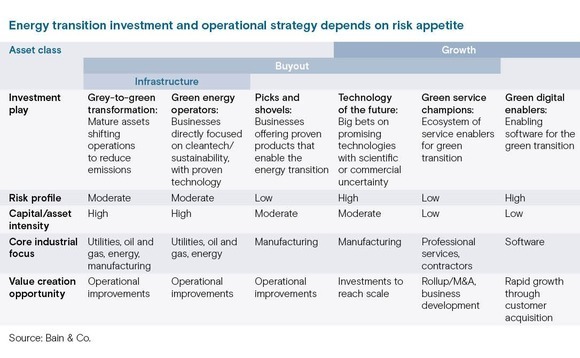
Energy transition: Getting comfortable

Private equity investors are leaning into energy transition with new funds, strategies, and attitudes about risk as more emerging categories go mainstream. Regulation remains the perennial spoiler
Recognising a blended risk-return profile in tech-enabled infrastructure and adjacent energy transition business models, Australia's Pacific Equity Partners (PEP) raised AUD 600m (USD 385m) for a secure assets fund in 2018. The goal was to combine annuity income with private equity-style operational improvement.
It speaks volumes of the state of this concept that Fund II closed earlier this year with more than double the firepower at AUD 1.4bn.
To be clear, PEP's secured assets platform was never specified as an energy transition strategy, but every investment from Fund I and everything in the Fund II pipeline fit either squarely in the theme or consider it core to the deal thesis. Fund I, now fully deployed, is sitting on a 3x return and an IRR of 88%; the target range was sub-20%.
The latest deal from Fund II, now 27% deployed, reveals a few ingredients in the secret sauce. In September, PEP invested AUD 272m in a 50% stake in Australian biogas-to-energy business LMS Energy. As part of the deal, the private equity firm will support up to AUD 200m in spending on growth initiatives across bioenergy and methane abatement in Australasia and the US.
Much of the logic was based on the policy environment: Australia's push to make nationwide power generation 82% renewable by 2030 creates an opening for gas to play a bigger role in the energy mix as a coal substitute. This is seen as a multi-decade opportunity for gas, whether or not the renewables target gets pushed back.
PEP also likes the distributed nature of LMS; it operates 36 biogas-to-energy facilities and 26 biogas flaring facilities. Large single-asset bets on energy transition are slow to bring online in Australia leaving little room to flex private equity strengths. Networks of more modular concepts the likes of microgrids, home batteries, virtual power plants, and smart metering are therefore favoured.
"Irrespective of whether you are a diversified infrastructure fund, energy specific, or a generalist private equity fund, energy transition is a multi-decade thematic that touches all sectors of the economy," said Paul Foster, co-head of PEP's secured assets programme.
"Even if you're not investing directly in the energy value chain, there is no industry that isn't being touched, transformed and impacted by energy transition. In that respect it is a structural theme that you cannot avoid from an opportunity and risk perspective, irrespective of your underlying investment strategy."
A definition question
The momentum behind the creation of discrete funds and strategies in this vein reflects an industry attempt to adapt. In addition to PEP, standout operators in the region include CelerateX, a unit of Kerogen Capital, and Decarbonization Partners, a joint venture between Temasek Holdings and BlackRock.
Meanwhile, KKR has formalised an Asia climate strategy, led by Neil Arora, who was recruited last year from Green Investment Group, itself an in-house climate and energy transition platform of Macquarie Asset Management.
With energy transition estimated to require some USD 5trn in funding a year for the foreseeable future, there are no shortages of new business models and subsegments to back and therefore no shortage of boxes to be filled across the risk-return spectrum. As Sebastien Lamy, co-head of Asia private equity at Bain & Company, put it: "It's actually creating new strategies on top of existing ones."
Lamy ties this development to private equity's challenges in recent years in terms of sourcing energy transition assets with the appropriate risk-return profile. There is no one-size-fits-all approach, but the general idea is to target IRRs in the mid-teens by building out physical, long-duration assets with contractual cashflows and technological barriers that deliver some outsized upside potential.
The risk appetite of these platforms, as they proliferate, will be determined by their skills base. Whatever industries are analogous to an investor's existing value-add capabilities will likely be the focus of the fund and therefore determine its shading on the spectrum between infrastructure and venture. For many, asset-light energy industry service providers will be the lowest-hanging fruit.
"We're starting to see funds widen their definition of what is infrastructure as part of the energy transition. Carbon credits are now being deemed infrastructure by some funds," said Liam Connolly, partner at Bain & Company focused on energy and private equity.
"It's something funds are working through. How do we best play the energy transition with our current mandate or by raising new funds that are either climate funds or generalist funds? How do we think about emerging technologies that have real growth potential but might not fit our mandate today?"

As recently as 2017, plays in this space were not well defined. That's when The Riverside Company acquired Energy Exemplar, an Australian simulation software provider for power stations and related facilities. Riverside saw a category leader in an evolving industry but had no energy transition thesis per se.
Fast-forward to last week: The Blackstone Group and Vista Equity Partners bought the business for a reported USD 1bn, touting an opportunity to service expanding renewable energy, battery storage, and related transmission grid installations. Blackstone invested via a dedicated global energy transition business currently raising its latest vintage with a target of USD 6bn.
"We recognised that this was a customer base that is going through change, and we can win as the change occurs. If you go back to our original investment committee discussions and notes, you won't see the term energy transition, but you will see all of the thematics that ultimately underly what we now call energy transition," said Simon Feiglin, Riverside's Australia lead.
Plotting a course
Energy transition is comparable to previous industrial disruptions in its most acute due diligence considerations. As with the rise of financial technology or the advent of the internet, jurisdiction-specific regulatory regimes are a core uncertainty factor, as are cashed-up incumbents looking to protect their legacy models as long as possible.
The theme is unique, however, in its heavy tilt toward real assets and hardware, which causes supply chains to become a recurring sticking point. Key raw materials and components can be hard to access and expensive. Lithium and copper, for example, have proven difficult to substitute in many applications. Crucially, such shortages can have knock-on effects in indirectly dependent businesses.
Bain Capital breaks energy transition due diligence into three core areas. Technology readiness: One-to-N is the preferred journey, not zero-to-one. Market readiness: An overarching policy framework is a must though not necessarily in the form of subsidy support. Competition pressure: What are the barriers to new supply meeting demand?
The firm ticked all three boxes in January when it invested an undisclsoed sum for a 43% stake in Hong Kong-based biorefinery EcoCeres in a partnership with local utility Towngas, which also took 43%. Core to the thesis is a burgeoning sustainable aviation fuel (SAF) offering. SAF was estimated to be a USD 400-USD 500m market in 2022 and is projected to be worth up to USD 27bn in 10 years.
EcoCeres is one of only a handful of companies globally to commercialize a SAF product, effectively satisfying concerns around technology and competition risk. Bain's comfort in terms of market readiness is significantly based on EU regulations that will require 70% of all jet fuel used in flights touching Europe to be blended with SAFs by 2050.
SAF is also central to the plan of recasting EcoCeres as a global company. A new factory is being brought online in Malaysia, new offices are being set up across Asia and Europe, and there has been significant investment in sales and senior management recruitment. James Tam, a partner at Bain Capital, said the buildout requires a new, albeit not altogether unfamiliar, skillset.
"Around the turn of the century, TMT [technology, media, and telecom] was just picking up, but now there is a whole generation of investors that know it inside out. Likewise, starting from now into the next 20 years, there will be a new generation of investors in private equity that will specialise in energy transition," Tam said.
"From a perspective of developing private equity capabilities, green economy and energy transition is the new TMT. We are organizing our effort around these themes. We don't see them as episodic. It's a serial trend to invest in, and we want to use each situation to learn more and expand our network and capacity."
Into the weeds
One of the key lessons for private equity in this case study is that identifying energy transition opportunities can be a matter of digging into unfamiliar or even unpopular categories. Tam emphasised that Bain Capital didn't allow the environmental spectre around crop-based biofuels to cloud its judgment of EcoCeres, which uses more sustainable waste-based feedstocks.
The apparent ramp-up in activity around alternative fuels also hints that a new understanding of energy transition risk-reward profiles and opportunity sets is starting to bring much-needed diversity to the theme.
According to the International Renewable Energy Agency (IRENA), 95% of investment in energy transition-related businesses – including transportation – is channelled toward low-risk wind and solar power generation assets. Vehicle electrification, for example, although de-risked in technology terms, is still seen as limited by uncertainty variables in charging infrastructure and how urban grids will handle the increased load.
Clean Energy Finance Corporation (CEFC), an independent, Australian-government-backed investor, aims to be part of the solution by pricing risks that generalist investors cannot and then crowding in as much private sector capital as it can.
To date, this effort has been mostly fruitful in still relatively mature domains such as wind farms that have not yet secured offtake agreements, although it is also being explored in electric vehicles (EVs).
As a specialist, CEFC, which is an LP in PEP's second secured assets fund, has a wider menu than most investors in terms of risk appetite; investees include Ark Energy, a hydrogen fuel maker for electric trucks. But its due diligence parameters are not uncommercial.
"Ultimately, it comes down to how the economics stack up. A lot of companies have the best ideas in the world, but they don't have the capacity to actually carry projects through," said Nicolas Hawke, a director at CEFC.
"Energy is a really capital-intensive industry, so you need big players standing behind the projects to ride through cost overruns or difficulties. That's a sticking point why we don't see technologies take off. They just don't have the scale to establish themselves."
The venture capital end of energy transition is marked by significantly higher risk profiles balanced by lower capital intensity and some surprising go-to-market and capital efficiency advantages in hardware versus software.
James Mi, founding partner of Lightspeed China Partners, illustrates the hardware point by observing that all the major internet companies in China have a combined market capitalisation of USD 1trn, which is equal to the top 60, relatively anonymous climate-tech companies.
The hardware-software divide is perhaps most striking in the ongoing boom around generative artificial intelligence (AI), where ChatGPT owner OpenAI is currently posting USD 1.3bn in annualised profit versus USD 6bn for chipmaker Nvidia. In many hardware categories, Asia, and especially China, is seen as having unique supply chain advantages.
Mi, a physicist by training who was a senior executive at Google and an early investor in Baidu, has helped Lightspeed China shift from an internet to an energy transition focus in recent years. He has an aversion to technologies propped up by subsidies and a preference for "picks and shovels" technology, including hydrogen fuel cells and electrolyser equipment.
"Innovation in material science is a lot harder than software. There's a lot of cross-discipline innovation happening that requires the investment team to have good domain knowledge to make judgements," he said. "The investment team profile for climate tech is quite different from an internet investor. You need deep experience in climate tech sectors."
Policy permutations
Picks and shovels have also proven appealing in the buyout end of the market, although the more mature nature of business models tends to introduce a greater competition risk factor.
This was Primavera Capital's experience in 2021 when it invested USD 600m in Chinese wind turbine components supplier Envision Group. At the time, the private equity firm saw intensified price competition – and subsequent margin pressure – as its greatest downside risk. That landscape is now said to be in a normalisation process, allowing Envision to expand its market share.
"We believe energy transition is too important to miss, especially for a PE investor with a good presence in China, which is now leading the global energy transition," said William Wang, a founding partner of Primavera.
"In global renewable energy investment rankings, China has the majority of total global manufacturing capacity and technologies, as well as brands in wind, solar and battery, and EV. We must capture this fast-growing sector, for financial returns and also for a sustainable future."
In understanding that this fluctuation in competition was regulation-driven, Envision underlines what is arguably the most pervasive and difficult-to-calculate risk factor in energy transition. Historically, renewable energy projects have been closely associated with government policy and subsidies, leading to episodes of disorderly rollouts, delayed development timelines, and mispriced risk.
Michael Taylor, head of renewable energy costs and outlook at IRENA, notes that the overall policy challenge even extends to government-connected entities specifically mandated to act as catalysts for private investments. He noted that development finance institutions, for example, have been criticised for being bureaucratic and inefficient in de-risking underinvested segments.
To mitigate this effect, IRENA advises investors to seek more detailed dialogues with policymakers, clarifying their needs and expectations in terms of alleviating supply chain risks, grid access risks, and project timeline variables such as permitting difficulties. In many markets, this is already happening, but something clearly isn't getting communicated.
"The problem is that governments and policymakers are still stuck in the 2010s when the focus was on driving down costs for renewable power generation and getting value for consumers. That's done now," Taylor said. "The business case for renewable power in most countries is quite compelling, but the policy frameworks are not sufficiently flexible to acknowledge the different dynamics."
Latest News
Asian GPs slow implementation of ESG policies - survey
Asia-based private equity firms are assigning more dedicated resources to environment, social, and governance (ESG) programmes, but policy changes have slowed in the past 12 months, in part due to concerns raised internally and by LPs, according to a...
Singapore fintech start-up LXA gets $10m seed round
New Enterprise Associates (NEA) has led a USD 10m seed round for Singapore’s LXA, a financial technology start-up launched by a former Asia senior executive at The Blackstone Group.
India's InCred announces $60m round, claims unicorn status
Indian non-bank lender InCred Financial Services said it has received INR 5bn (USD 60m) at a valuation of at least USD 1bn from unnamed investors including “a global private equity fund.”
Insight leads $50m round for Australia's Roller
Insight Partners has led a USD 50m round for Australia’s Roller, a venue management software provider specializing in family fun parks.







